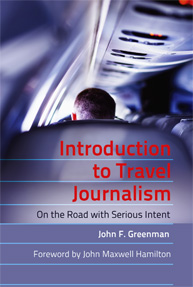A city guide in 48 hours
Posted: May 3, 2013 Contents: Chapter 2, Chapter 3 | Tags: Bill Addison, national geographic, national geographic traveler, travel journalism, travel journalist, travel research, travel writer, travel writing Leave a comment »Chapter 2 makes a claim that guidebooks are essential to the tourism process. Taken a step further, Chapter 3 discusses the essential skills and knowledge for a travel journalist creating a travel guidebook such as: find the “hidden,” secret” attractions that “nobody knows.” Bill Addison a National Geographic traveler has offered his version of these valuable guides.
Here’s what’s good about Addison’s post: one, which is reflected within the title of the article, Addison tackles a city in 48 hours. He breaks down the article in sections depicting activities ranging from the historical MLK house, Oakland cemetery, & historic eateries to contemporary museums, hangouts and restaurants. Two: each day is broken down into morning, afternoon, and evening segments. Each segment is filled with activities that seem to ensure a complete Atlanta experience.
However, the traveler should use this guide much like other travel guides, as a suggestion to how to…
Tourism’s dark side
Posted: May 3, 2013 Contents: Chapter 6 | Tags: Heather Greenwood Davis, national geographic, national geographic traveler, travel advice, travel journalism, travel journalist, travel writer, travel writing Leave a comment »Chapter 6 encourages the travel journalist to write about the “worst” in travel. Heather Davis of National Geographic.com describes her family’s tough experience while traveling in China. More important than her stories of locals snapping pictures of her family at random and reaching out to touch their hair, are the lessons she learned after the experience. Here’s a bit from Davis’ piece:
As a family that believes there are things to be learned from everything in life, we try to turn even the most frustrating experiences into teachable moments. — Having your every move documented gets old, and quickly. The celeb-obsessed culture prevalent in many parts of the world can desensitize us to what it’s like to be on the other end of the lens. Our experience in China showed us how photo taking can go over the line and taught us to be better at…
The quest: Brett Rogers’ India
Posted: April 3, 2013 Contents: Chapter 3 | Tags: Brett Rogers, Ganges River, national geographic, religious pilgrimage, travel journalism, travel journalist, travel writing Leave a comment »Brett Rogers of National Geographic provides a proper example of other niche topics worth considering: Religious pilgrimages. Chapter 3 of the book explains, the value of the religious pilgrimage lies in the search for moral or spiritual significance — the quest. Roger’s quest begins with descriptions of the gripping landscapes of the mystical Ganges River in India before reverting to the reasons for his personal journey.
Here’s what’s good about Roger’s piece: The author uses journalistic techniques to compare and represent Western ideals against (Eastern) Indian culture. Through observation and interview Rogers seem to have completed his experience gaining a deeper understanding of death through the eyes of foreign culture….
Wine over ice
Posted: March 13, 2013 Contents: Chapter 3 | Tags: ice age trail, laurentide ice sheet, national geographic, sally younger, travel journalism, travel journalist, travel writer, travel writing, Von Stiehl Winery, wisconsin Leave a comment »Chapter 3 claims food and wine is an important niche’ topic to travel journalism consumers. The text details information on the audience, angles to pursue, an example of best coverage, and where you can learn more. Sally Younger of National Geographic pursues her wine story from an unexpectedly unique angle. The author describes in vivid details her surroundings as she catches a rest from her adventurous Ice Age Trail journey. What starts off as an adventure/ journey piece describes a destination as remarkable as the historic Ice Age Trail itself. A town with underground tunnels, grand fishing and more importantly great wine is set in a historical Ice age Trail.
Younger utilizes all of her travel journalism skills beyond observation by offering quotes from the locals that add validity to her story. The author uses sounds, feels, color, and descriptions of taste that takes the reader out of his chair and into the tavern in Wisconsin. Younger provides a prime…
Safety first, deploy decoy wallet
Posted: October 28, 2012 Contents: Chapter 4 | Tags: christopher elliot, national geographic, safety travel tips, travel advice, travel journalism, travel safety, travel writer, travel writing 1 Comment »Chapter 4 gives the travel writer two pieces of pre-travel advice on safety while traveling. Christopher Elliott of The National Geographic adds to this advice by offering the writer tips to solve every crisis during travel. Elliot offers this bit:
Regardless of your locale, always watch your things when in a new place. Carry a throwaway wallet or decoy purse containing daily cash and old photos but nothing that would make you hesitate to hand it over in a holdup. Keep a credit card and cash in an inside pocket. 1. Hand over the fake wallet. 2. Notify the police.
Do not hesitate to hand over anything in a hold up, no material object is worth risking your life.
